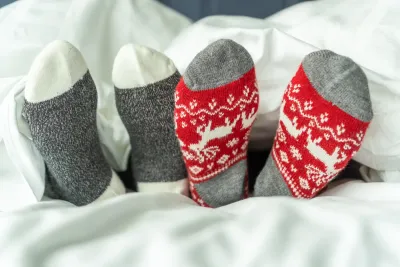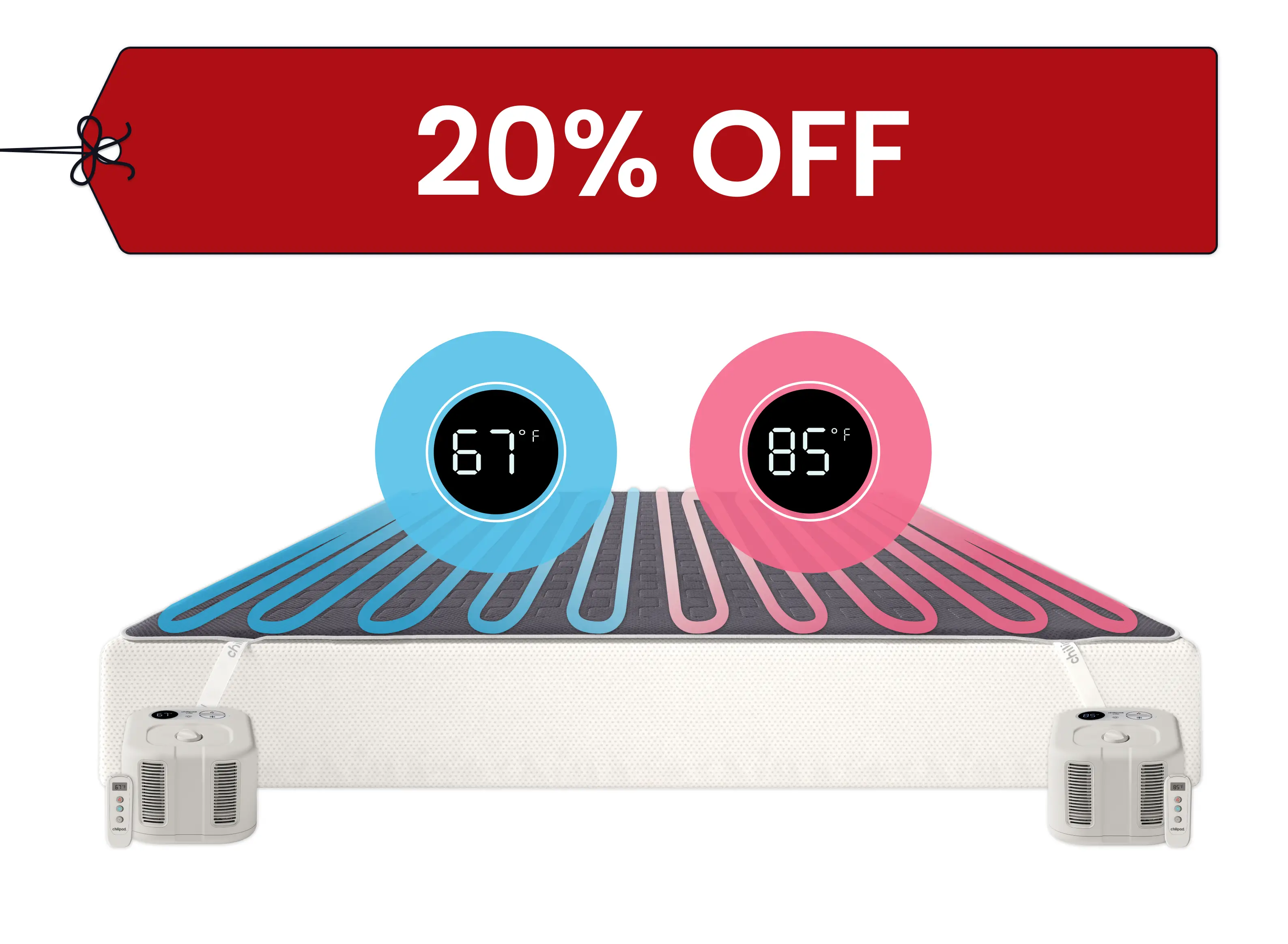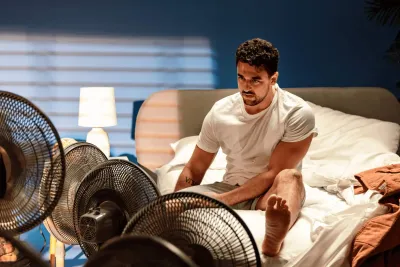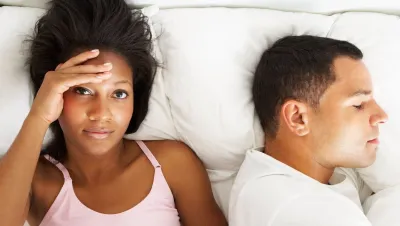
Key Takeaways
- Fall Asleep Faster: Wearing socks can help you fall asleep about 7.5 minutes faster by triggering distal vasodilation, which lowers your core body temperature for better rest.
- Surprising Benefits: Beyond warmth, socks can ease Raynaud’s symptoms, reduce menopausal hot flashes, boost intimacy, and even improve skin hydration overnight.
- Quality Gains: A 2018 Physiology Study showed socks can add 32 minutes of sleep, cut nighttime wake-ups by 7.5 times, and improve sleep efficiency by 7.6%.
- Smart Choices: Opt for loose-fitting, breathable natural fibers like cotton, merino wool, or bamboo; avoid synthetics that trap heat and moisture.
- Know the Limits: While generally safe, avoid tight compression socks and ensure proper blood circulation when wearing socks to bed
If someone told you that a simple pair of socks could help you fall asleep faster, actually 7.5 minutes faster, would you believe them? Research conducted by the Journal of Physiological Anthropology suggests this seemingly odd sleep hack isn’t just what your grandmother recommended—it’s backed by solid science. [1]
While many people instinctively kick off their socks before bedtime, evidence suggests that wearing socks when sleeping might actually be the key to better sleep.
The connection between your feet and sleep is more important than just comfort. Your body naturally controls its temperature to help you fall asleep faster, and your feet play a key role in this process by helping regulate temperature.
When you understand how warming your feet can trigger a cascade of physiological changes that promote sleepiness, the practice of using socks for sleep begins to make perfect sense.
The Science Behind Your Feet and Sleep
Every night, your body follows a natural temperature cycle to get ready for sleep. As bedtime approaches, your core body temperature drops by about 1–2 degrees, telling your brain it’s time to sleep. This isn’t random, it’s a built-in part of your circadian rhythm that’s been hardwired into humans for millions of years.
Here’s the science lesson: it all starts with something called distal vasodilation. When your feet warm up, the blood vessels in your hands and feet widen, boosting blood flow to these areas. This extra blood circulation helps move heat from your core out to your extremities, lowering your internal temperature while keeping your hands and feet nice and cozy.
Cold feet at night do the opposite of helping you sleep. They cause blood vessels to tighten, keeping your core temperature higher and making it harder to drift off. In fact, research shows cold toes can lead to a longer time falling asleep and more nighttime wake-ups.
Your feet have special blood vessels that work like tiny radiators, adjusting blood flow to help control body temperature. Wearing socks helps these “radiators” do their job, keeping your body in the ideal comfort zone. Even in a perfectly cool room (65–68°F), warm feet can make all the difference for restorative sleep.
Cozy Toes, Cooler Sleep
Socks bring the warmth, Chilipad brings the chill. Pair them together and you’ve got the perfect balance for a cozy, comfortable night’s sleep.
The Many Benefits of Wearing Socks to Sleep
When it comes to getting better rest, this simple bedtime habit offers more perks than you might expect. Here are the key benefits of wearing socks to sleep.
Sleeping Better with Raynaud’s Syndrome
For people with Raynaud’s syndrome, cold feet at night can be more than a minor discomfort — they can trigger painful circulation changes that interrupt sleep. Wearing socks to bed offers simple, steady warmth that helps keep blood flowing and lowers the chance of nighttime flare-ups.
Soft, temperature-regulating fabrics such as wool, merino wool, or bamboo provide comfortable warmth without making you feel too hot, helping you stay relaxed and asleep through the night.
Reducing Menopausal Hot Flashes
You wouldn’t think wearing socks could help with menopause hot flashes, but it just might. Menopause can throw your body’s temperature regulation into chaos, thanks to fluctuating hormones. For many women, this means sudden spikes in core temperature, followed by sweating and discomfort that make quality sleep feel impossible.
Surprisingly, keeping your feet warm at night can help steady your overall body temperature. When your feet are warm, your body doesn’t have to pull blood away from them to maintain core heat, which can lead to more stable thermoregulation. This stability may help reduce the intensity and frequency of nighttime hot flashes.
While more research is needed, many women swear that something as simple as slipping on a pair of breathable socks helps them sleep cooler, longer, and with fewer temperature swings during the night.
Study: A Wake Forest University Study Revealed Chilipad Helps Reduction in Hot Flash Severity and Frequency
Improve Intimacy and Sexual Health
Believe it or not, socks might boost more than just your sleep. A 2005 study found that couples wearing socks during intimacy reached orgasm 80% of the time, compared to just 50% without. The reason? Warm feet improve blood flow, which can enhance comfort and physical response.
Cold feet can throw off your focus fast — whether you’re trying to fall asleep or enjoy a moment with your partner. Keeping them warm with socks removes that uncomfortable distraction, helping you relax and stay present. And while the research is still growing, many people notice that better warmth and steady circulation can support a more comfortable, connected experience. Comfort really does matter in all the small moments.
Foot Care and Moisturization Benefits
Foot Care and Moisturization Benefits
Socks at night aren’t just about staying warm — they can make a noticeable difference in keeping your feet soft and healthy. Applying a rich foot cream or balm before putting on breathable cotton socks helps lock in moisture, giving dry or cracked heels a chance to heal while you sleep.
The gentle warmth from the socks softens rough skin and supports quicker healing of minor cracks or irritation. This simple approach is often recommended by dermatologists, especially in dry climates or during winter when skin loses moisture more quickly. As a bonus, the socks keep your lotion where it belongs instead of on your sheets.
For the best results, use a thicker balm or a petroleum-based product, then let your socks act as an overnight hydration helper. Over time, this easy bedtime routine keeps your feet smooth, comfortable, and ready for the day ahead.

Other Benefits of Wearing Socks:
A few interesting findings from published sleep research show that warm, comfortable feet can do more than you might expect:
- Longer Sleep Time: People who wore socks to bed slept about 32 minutes longer on average. [2]
- Fewer Wake-Ups: Participants woke up far less often — about 7.5 fewer awakenings throughout the night. [3]
- Better Sleep Quality: Sleep efficiency improved by 7.6%, thanks to steady foot warmth that supported comfort without raising core body temperature or heart rate. [4]
- Comfort in Every Season: Lightweight, breathable socks keep feet warm even in summer, especially with air conditioning or a bed fan cooling the room.
- Improved Circulation: Gentle warmth supports blood flow in the lower legs, which may help reduce cramps or restless leg discomfort.
- A Helpful Sleep Cue: Slipping on “sleep socks” becomes part of a calming bedtime routine, giving your body a clear signal that it’s time to wind down.
Downsides of Wearing Socks to Sleep
Even with all the perks, sleeping in socks isn’t for everyone. Here are some things to keep in mind before making it part of your nightly routine:
Risk of Overheating
In warmer climates or if your bedroom is above 70°F, socks can trap excess heat and interfere with your body’s natural cooling process, making it harder to fall and stay asleep.
Circulation Concerns
Circulation issues can occur when socks are too tight or restrictive. Very snug compression styles may limit blood flow during the night, and strong elastic bands around the ankles or calves can create pressure points if worn for long periods. Choosing a softer, more flexible pair helps avoid these problems and keeps your feet comfortable while you sleep.
Moisture & Odor Buildup
Synthetic fabrics such as polyester feel good, but they can trap sweat and create the perfect environment for bacteria, which often leads to that nasty foot odor. This occurs because, when socks don’t allow enough airflow, your feet can stay damp, making fungal infections and unpleasant smells occur.
If this happens, you can choose breathable, moisture-wicking socks that helps keep your feet dry, comfortable, and healthier overnight.
Comfort Preferences
Some people just sleep better without socks. If you naturally run hot or enjoy the cool feel of sheets on your bare feet, wearing socks may feel uncomfortable and could make it harder to settle into restful sleep.
Special Health Considerations
People with diabetes or circulation disorders should take extra care when wearing socks to bed. Reduced sensation in the feet can make it difficult to notice if socks are too tight or creating pressure. Make sure to check with your doctor or healthcare provider, making sure its safe - whether wearing socks at night is appropriate for your situation.
The Best Socks for Sleeping
Finding the perfect pair of sleep socks comes down to comfort, breathability, and the right materials—here’s what to look for when choosing socks for bedtime.
- Go for a Loose Fit: Pick socks that are non-restrictive and won’t leave marks or cut off circulation. Non-binding tops are ideal.
- Choose Natural Fibers: Cotton is breathable and great at absorbing moisture, making it ideal if you tend to sweat at night. Merino wool adapts to your body temperature—keeping you warm when it’s cool and wicking moisture when it’s warm. Bamboo is super soft, moisture-wicking, and naturally antimicrobial, helping prevent odor and bacterial growth.
- Avoid Polyester: Synthetic fabrics trap heat and moisture, creating a clammy, uncomfortable environment.
- Consider Options: Cashmere or silk offer luxury softness and temperature regulation but require special care and may not be practical for everyday use.
- Look for Comfort Features: Seamless or flat seams prevent pressure points. Skip thick cushioning—breathability and softness matter more for sleep.
Sleep Hygiene and Sock-Wearing Habits
Wearing socks can boost your sleep hygiene and bedtime routine, but timing and choice matter. Slip them on about 30 minutes before bed to warm your feet and trigger the sleep-friendly vasodilation process.
Match sock weight to your room temperature—medium for 65–68°F, thicker for cooler nights, and lightweight, breathable pairs for warmer conditions. In summer or hot climates, try warming your feet for 20–30 minutes before bed, then removing the socks to avoid being too hot.
Keep a few pairs of clean, dedicated sleep socks in different materials and thicknesses so you can adjust for seasonal changes, illness, or shifts in temperature sensitivity. This way, you’ll always have the perfect pair for a comfortable, uninterrupted night’s rest.
Final Thought
Wearing socks to bed might sound like a small change, but the science—and the benefits—speak for themselves. From helping you fall asleep faster and staying asleep longer to easing symptoms of Raynaud’s, reducing menopausal hot flashes, improving circulation, and even keeping your feet baby-soft, this simple habit can have a surprisingly big impact on your sleep quality.
Of course, socks at night aren’t for everyone. The key is finding the right fit, fabric, and timing for your body and environment. Lightweight, breathable natural fibers and a comfortable fit can help you reap the rewards without overheating or restricting circulation.
At the end of the day (literally), sleep is all about comfort, and if slipping on a cozy pair of socks before bed helps you drift off faster and wake up more refreshed, it’s worth making part of your nightly ritual. After all, better sleep could be just a pair of socks away.
Frequently asked questions
Is It Bad to Wear the Same Socks for Multiple Days?
Yes, wearing the same socks multiple nights without washing can lead to bacterial growth and unpleasant odors. Sleep socks should be changed daily, just like regular socks.
Can Wearing Socks to Bed Cause Foot Fungus?
Not if you keep things clean. Wearing socks to bed won’t automatically give you foot fungus, but trapping heat and moisture in a poorly ventilated, sweaty environment can create the perfect breeding ground for it.
If you’re team “sock sleeper,” opt for breathable, moisture-wicking materials and fresh pairs every night—because nothing says “good morning” like fungus-free toes.
Should People with Diabetes Wear Socks to Bed?
If you have diabetes, check with your doctor before making bedtime socks a habit. Since diabetes can reduce circulation and foot sensation, it’s harder to notice if socks are too tight or causing issues.
With your provider’s OK, stick to loose, non-binding socks and inspect your feet daily for irritation or circulation problems.
Why Do I Overheat When I Wear Socks?
If you wake up feeling too warm, simply remove your socks and allow your feet to cool naturally. Consider switching to lighter-weight socks or trying the pre-warming technique instead. This can include wearing socks for 20-30 minutes before bed, then removing them before sleep.
Should You Wear Compression Socks When Sleeping?
Short answer yes… but only in certain situations. Compression socks can help with circulation if you’re dealing with swelling or recovering from a heavy training day, but they’re not a nightly must-have.
For most people, wearing them while you sleep isn’t necessary and can even feel too snug. If you’re managing a medical issue or intense inflammation, talk to your doc first. Otherwise, stick to regular socks and keep the compression routine for daytime.
References
[1] Ko, Yelin, and Joo-Young Lee. “Effects of Feet Warming Using Bed Socks on Sleep Quality and Thermoregulatory Responses in a Cool Environment.” Journal of Physiological Anthropology, vol. 37, no. 1, 24 Apr. 2018. View Study
[2] Ko, Yelin, and Joo-Young Lee. “Effects of feet warming using bed socks on sleep quality and thermoregulatory responses in a cool environment.” Journal of physiological anthropology vol. 37,1 13. 24 Apr. 2018, View Study
[3] ibid
[4] Aijazi, Arfa et al. “Passive and low-energy strategies to improve sleep thermal comfort and energy resilience during heat waves and cold snaps.” Scientific reports vol. 14,1 12568. 31 May. 2024, doi:10.1038/s41598-024-62377-5 - View Study /









